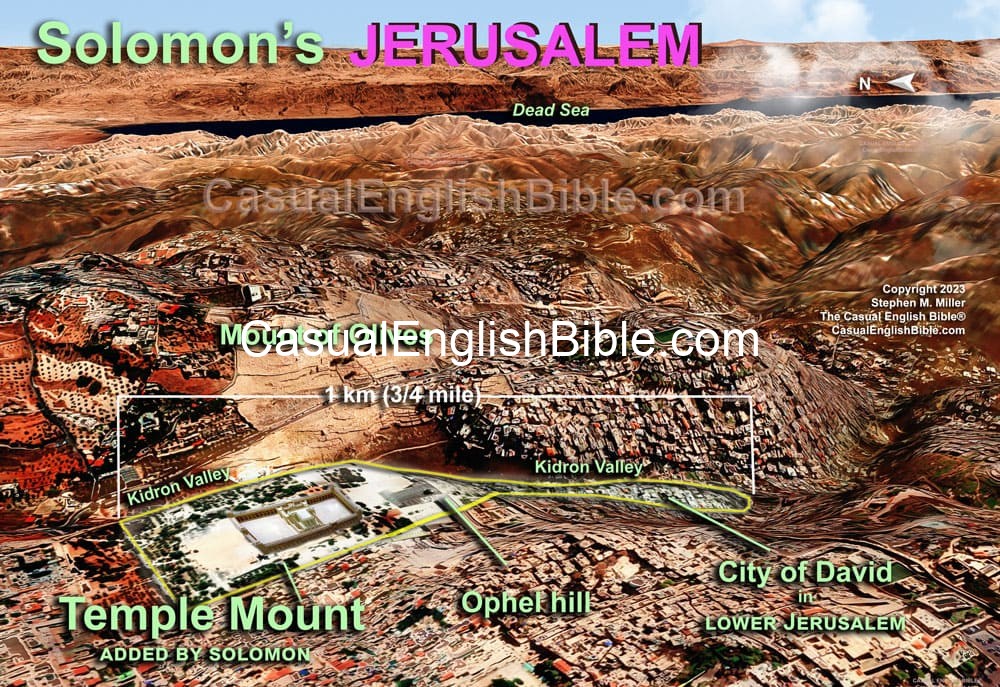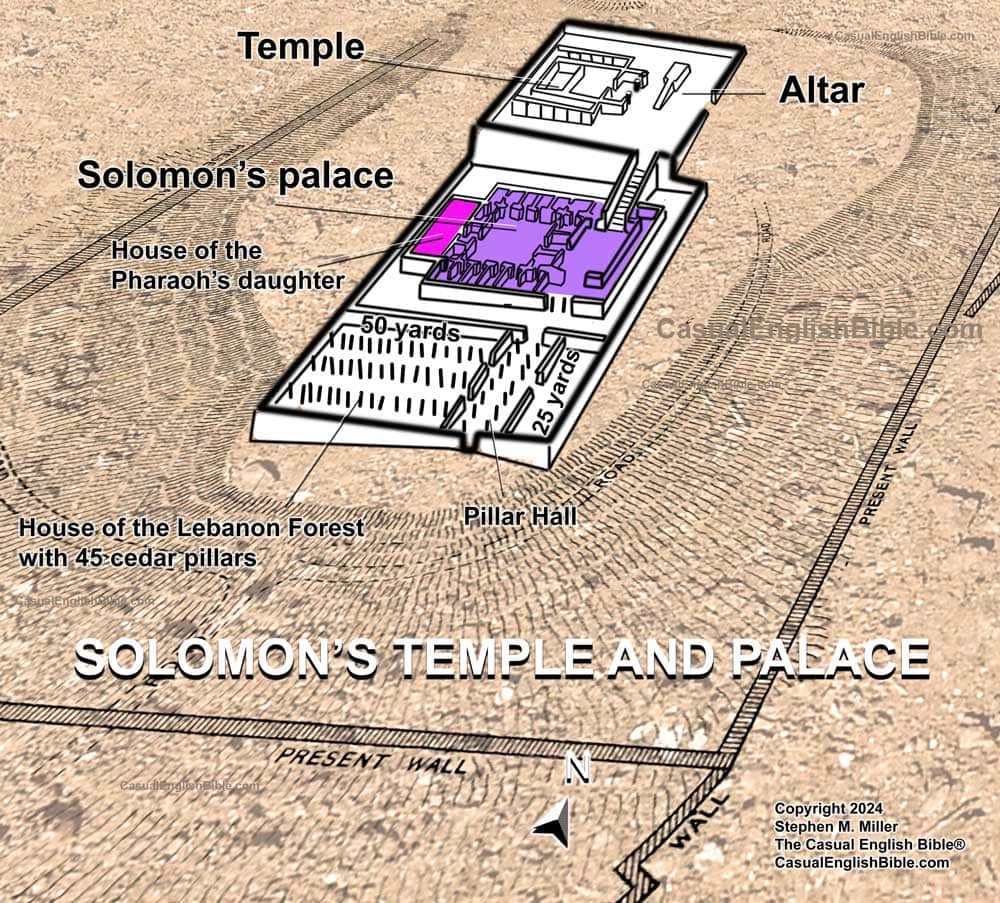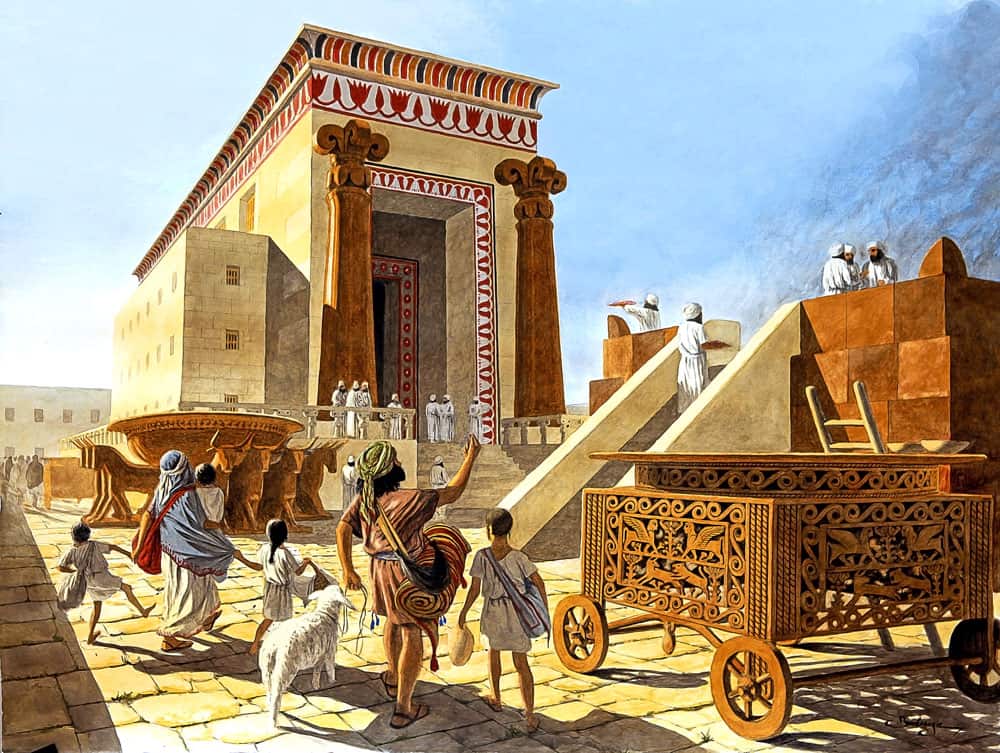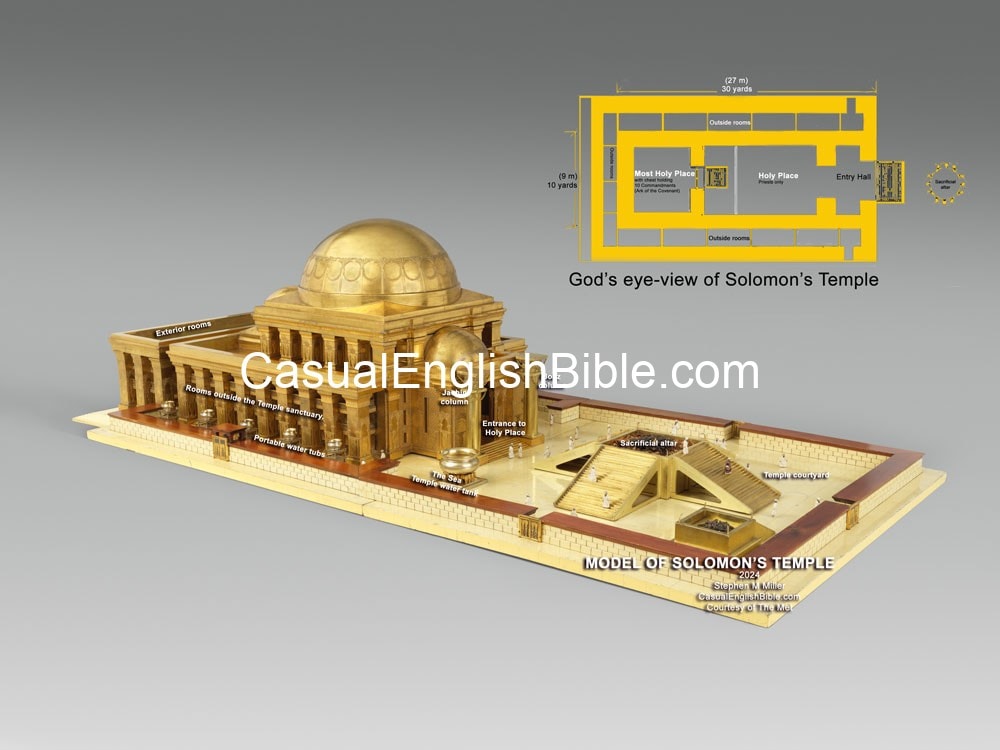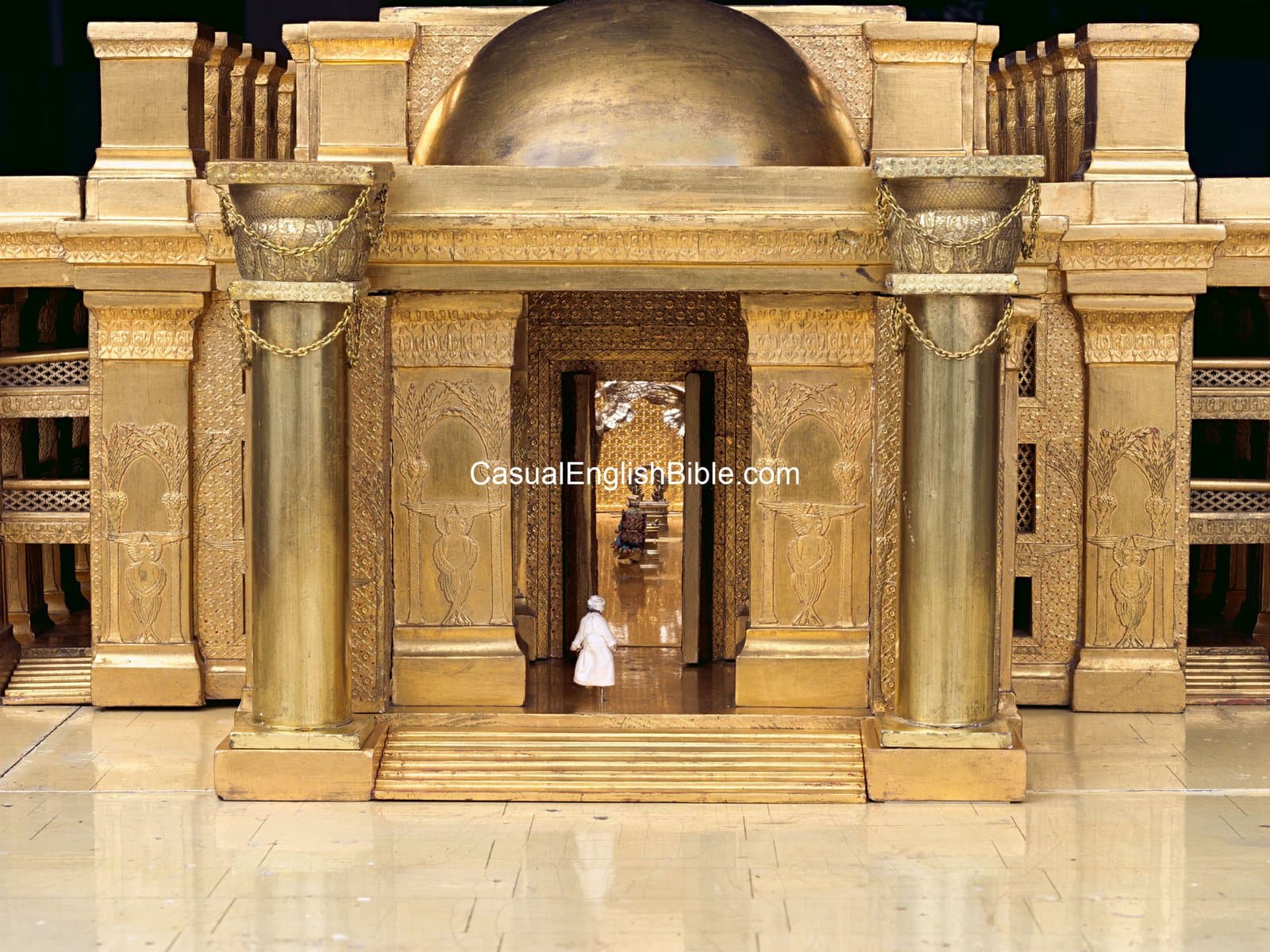2 Chronicles 3
Solomon panels Temple walls in gold
Temple under construction
1 Kings 6:1-38 1King Solomon’s workers started building the Jerusalem Temple on a flat slab of ground where a local farmer named Ornan used to thresh grain—shaking it loose from the stalks. That’s where the LORD had appeared to David years earlier and told him to build the Temple.
2It was springtime, in the second day of the Israelite month called Ziv. [1] Solomon was into his fourth year as king.
3Jerusalem’s first Temple measured 30 yards long, 10 yards wide, and 15 yards high. [2] 4Builders added a front porch 5 yards [3] deep, stretching all the way across the front of the building, for 10 yards.
5Solomon’s builders used cedar boards to lay the Temple floor and line the inside walls. Then they paneled it with the finest gold and decorated the walls with pictures of palm trees and golden chains. 6He added gemstones to the Temple décor, with gold from Parvaim. [4] 7Solomon had his workers line the Temple with gold—rafters, thresholds, walls, and doors. Artisans engraved images of cherubim on the golden walls. The Temple’s holiest room
8Solomon put the holiest room, [5] the Most Holy Place, at the back of the Temple. It was a cube-shaped room, 30 feet on all sides. Twenty tons [6] of the finest gold covered those inside walls, as paneling.
9Builders hammered timber together with gold nails that each weighed over a pound. [7] The king ordered gold paneling for upper rooms, too. Golden angels in the Temple
10For the Most Holy Place, he ordered two huge cherubim carved from wood and overlaid with gold. 11The cherubim had wings, with a wingspan as wide as they were tall. Each wing measured 7 ½ feet to the tip. The cherubim stood so close together that their wings tips touched. The other wing of each cherubim touched the wall. 12Both cherubim were positioned similarly, wing touching wing and the other wing touching the wall. 13Together, their wings stretched out 30 feet, [8] from one wall to the opposite wall.
14Solomon appointed artisans to create a curtain to cover the entrance into the Most Holy Place. They made it from fabric died in blue, purple, and crimson and they wove images of cherubim into the fabric. The Temple’s mysteriously named pillars
1 Kings 7:15-22 15Solomon ordered a pair of 37-foot [9] high pillars on each side of the main door into the Temple front room and sanctuary. Artisans crowned each one with a capital seven feet high. [10]
16He had workers decorate each capital with a design that looked like seven chains resembling nets. He added two rows of pomegranate art. 17The two pillars outside the front door into the Temple had names. Solomon called the pillar on the left, at the south side, Jachin. He called the pillar on the right side, which was north, Boaz. [11] Footnotes
13:1Ziv runs from mid-April to mid-May.
23:3That’s 27 by 9 by 13.5 meters. Some say this is inside of the Temple, not outside. In either case, the measurement doesn’t include storage rooms and living quarters attached to the outside of the Temple sanctuary (see 1 Kings 6:5). In the Hebrew system of measurements, the main part of the Temple without the outlying buildings, was 60 by 20 by 30 cubits. A cubit was the length of a man’s forearm, from elbow to fingertips. That’s roughly 18 inches or half a meter. Solomon built the Temple on the Jerusalem ridge where the Holy Land’s most famous landmark has stood for the past 1,400 years: Islam’s shrine, the Dome of the Rock.
33:4That’s 4.5 meters or 10 cubits in ancient Hebrew measurement.
43:6No one today seems to know where Parvaim was. The name shows up in other ancient writings as a place where the gold had a red hue, like the blood of a bull. There seems to have been different grades of gold at the time, but it’s unclear what they were.
53:8It was the holiest room because it held Israel’s most sacred relic, a gold-lined wooden chest that held the Ten Commandments etched onto stone from the time of Moses. Often called the Ark of the Covenant, which means Box of the Law, it was lost to history, possibly captured, and stripped of its gold by one of Jerusalem’s invaders. Babylonians leveled the Temple in 586 BC. There’s no mention of the chest’s existence after that.
63:8In ancient Hebrew measure, 600 talents. A “talent” is 34 kilograms or 75 pounds.
73:9Twenty ounces each, which is 570 grams or 50 shekels in Hebrew.
83:13Nine meters.
93:15That’s 11 meters or 35 cubits in Hebrew.
103:15Just over two meters, or five cubits.
113:17Similar pillars show up in the ruins and images of other ancient temples of the time. Some pillars were freestanding, and others were built into the walls to help support the structure. As for the names, it’s anyone’s guess why these names. Guesses include: these were the big donors, they referred to other gods, or they were a way of honoring and portraying God’s strength.
Discussion Questions
- Sorry, there are currently no questions for this chapter.
Videos
2It was springtime, in the second day of the Israelite month called Ziv. [1] Solomon was into his fourth year as king.
3Jerusalem’s first Temple measured 30 yards long, 10 yards wide, and 15 yards high. [2] 4Builders added a front porch 5 yards [3] deep, stretching all the way across the front of the building, for 10 yards.
5Solomon’s builders used cedar boards to lay the Temple floor and line the inside walls. Then they paneled it with the finest gold and decorated the walls with pictures of palm trees and golden chains. 6He added gemstones to the Temple décor, with gold from Parvaim. [4] 7Solomon had his workers line the Temple with gold—rafters, thresholds, walls, and doors. Artisans engraved images of cherubim on the golden walls.
The Temple’s holiest room
8Solomon put the holiest room, [5] the Most Holy Place, at the back of the Temple. It was a cube-shaped room, 30 feet on all sides. Twenty tons [6] of the finest gold covered those inside walls, as paneling.9Builders hammered timber together with gold nails that each weighed over a pound. [7] The king ordered gold paneling for upper rooms, too.
Golden angels in the Temple
10For the Most Holy Place, he ordered two huge cherubim carved from wood and overlaid with gold. 11The cherubim had wings, with a wingspan as wide as they were tall. Each wing measured 7 ½ feet to the tip. The cherubim stood so close together that their wings tips touched. The other wing of each cherubim touched the wall. 12Both cherubim were positioned similarly, wing touching wing and the other wing touching the wall. 13Together, their wings stretched out 30 feet, [8] from one wall to the opposite wall.14Solomon appointed artisans to create a curtain to cover the entrance into the Most Holy Place. They made it from fabric died in blue, purple, and crimson and they wove images of cherubim into the fabric.
The Temple’s mysteriously named pillars
1 Kings 7:15-22 15Solomon ordered a pair of 37-foot [9] high pillars on each side of the main door into the Temple front room and sanctuary. Artisans crowned each one with a capital seven feet high. [10]
16He had workers decorate each capital with a design that looked like seven chains resembling nets. He added two rows of pomegranate art. 17The two pillars outside the front door into the Temple had names. Solomon called the pillar on the left, at the south side, Jachin. He called the pillar on the right side, which was north, Boaz. [11] Footnotes
13:1Ziv runs from mid-April to mid-May.
23:3That’s 27 by 9 by 13.5 meters. Some say this is inside of the Temple, not outside. In either case, the measurement doesn’t include storage rooms and living quarters attached to the outside of the Temple sanctuary (see 1 Kings 6:5). In the Hebrew system of measurements, the main part of the Temple without the outlying buildings, was 60 by 20 by 30 cubits. A cubit was the length of a man’s forearm, from elbow to fingertips. That’s roughly 18 inches or half a meter. Solomon built the Temple on the Jerusalem ridge where the Holy Land’s most famous landmark has stood for the past 1,400 years: Islam’s shrine, the Dome of the Rock.
33:4That’s 4.5 meters or 10 cubits in ancient Hebrew measurement.
43:6No one today seems to know where Parvaim was. The name shows up in other ancient writings as a place where the gold had a red hue, like the blood of a bull. There seems to have been different grades of gold at the time, but it’s unclear what they were.
53:8It was the holiest room because it held Israel’s most sacred relic, a gold-lined wooden chest that held the Ten Commandments etched onto stone from the time of Moses. Often called the Ark of the Covenant, which means Box of the Law, it was lost to history, possibly captured, and stripped of its gold by one of Jerusalem’s invaders. Babylonians leveled the Temple in 586 BC. There’s no mention of the chest’s existence after that.
63:8In ancient Hebrew measure, 600 talents. A “talent” is 34 kilograms or 75 pounds.
73:9Twenty ounces each, which is 570 grams or 50 shekels in Hebrew.
83:13Nine meters.
93:15That’s 11 meters or 35 cubits in Hebrew.
103:15Just over two meters, or five cubits.
113:17Similar pillars show up in the ruins and images of other ancient temples of the time. Some pillars were freestanding, and others were built into the walls to help support the structure. As for the names, it’s anyone’s guess why these names. Guesses include: these were the big donors, they referred to other gods, or they were a way of honoring and portraying God’s strength.
Discussion Questions
- Sorry, there are currently no questions for this chapter.
Videos
16He had workers decorate each capital with a design that looked like seven chains resembling nets. He added two rows of pomegranate art. 17The two pillars outside the front door into the Temple had names. Solomon called the pillar on the left, at the south side, Jachin. He called the pillar on the right side, which was north, Boaz. [11]
Footnotes
Ziv runs from mid-April to mid-May.
That’s 27 by 9 by 13.5 meters. Some say this is inside of the Temple, not outside. In either case, the measurement doesn’t include storage rooms and living quarters attached to the outside of the Temple sanctuary (see 1 Kings 6:5). In the Hebrew system of measurements, the main part of the Temple without the outlying buildings, was 60 by 20 by 30 cubits. A cubit was the length of a man’s forearm, from elbow to fingertips. That’s roughly 18 inches or half a meter. Solomon built the Temple on the Jerusalem ridge where the Holy Land’s most famous landmark has stood for the past 1,400 years: Islam’s shrine, the Dome of the Rock.
That’s 4.5 meters or 10 cubits in ancient Hebrew measurement.
No one today seems to know where Parvaim was. The name shows up in other ancient writings as a place where the gold had a red hue, like the blood of a bull. There seems to have been different grades of gold at the time, but it’s unclear what they were.
It was the holiest room because it held Israel’s most sacred relic, a gold-lined wooden chest that held the Ten Commandments etched onto stone from the time of Moses. Often called the Ark of the Covenant, which means Box of the Law, it was lost to history, possibly captured, and stripped of its gold by one of Jerusalem’s invaders. Babylonians leveled the Temple in 586 BC. There’s no mention of the chest’s existence after that.
In ancient Hebrew measure, 600 talents. A “talent” is 34 kilograms or 75 pounds.
Twenty ounces each, which is 570 grams or 50 shekels in Hebrew.
Nine meters.
That’s 11 meters or 35 cubits in Hebrew.
Just over two meters, or five cubits.
Similar pillars show up in the ruins and images of other ancient temples of the time. Some pillars were freestanding, and others were built into the walls to help support the structure. As for the names, it’s anyone’s guess why these names. Guesses include: these were the big donors, they referred to other gods, or they were a way of honoring and portraying God’s strength.
Discussion Questions
- Sorry, there are currently no questions for this chapter.





